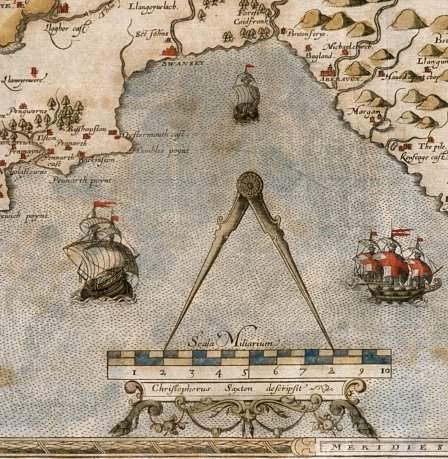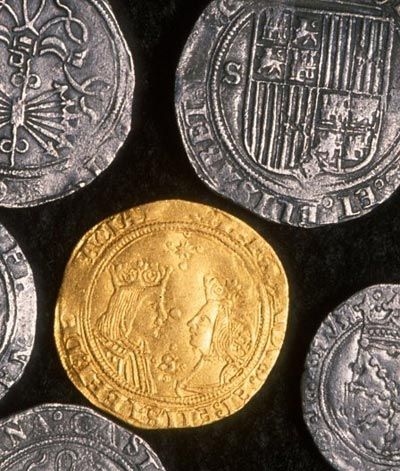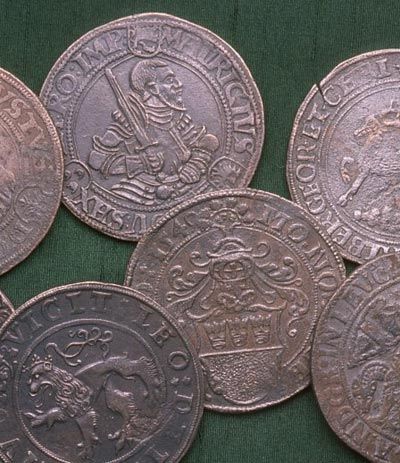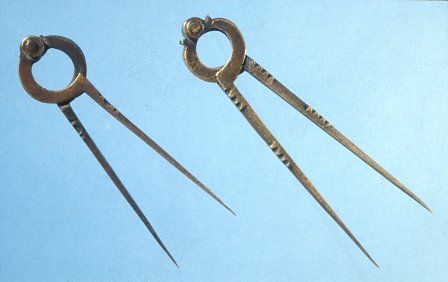The wreck of the Ann Francis

A detail of Christopher Saxton's Map of Glamorgan, 1578, showing the coastline from Oxwich on Gower (left) to Margam (upper right).

Spanish gold and silver coins of Ferdinand and Isabella (1479-1504). Coins continued to be minted in their names long after their deaths, until the 1550s.

: large silver coins from Germany. This group includes issues of the Electors of Saxony, Counts of Stolberg, Langraves of Leuchtenberg and the cities of Cologne and Herford. The modern word 'Dollar' originates from Talers

A gold San Vicente of John III of Portugal (1527-57); the reverse (right side of image) depicts the saint holding a martyr's palm and a model ship.

Navigational dividers from the wreck of the Ann Francis.
Spanish coins, navigational tools and a whistle- are these the remains of the 16th-century vessel, the Ann Francis?
For many years, coins and other objects have been found on Margam Beach in Glamorgan. Many are of relatively recent date, but there is a noticeable concentration of coins dating from the middle of the 16th century.
Most of these coins are silver: of Ferdinand and Isabella of Spain and from a number of states of the German Holy Roman Empire. There are a few copper coins of John III of Portugal (1521-57) and even two spectacular gold coins - one Spanish and one Portuguese. Throw in sets of navigational dividers, lead sounding weights and a bosun's call (whistle) and what have you got? A shipwreck.
Most of the coins date from the 1530-1557. It is known that a French ship was lost in December 1557 at Oxwich on the Gower, 21km (14 miles) to the west - but is there no suitable wreck closer to Margam?
Well, a 16th-century wreck is known at Margam, but not in 1557. On 28 December 1583, the Ann Francis, the newest and biggest ship belonging to the King's Lynn merchant Francis Shaxton, ran aground on Margam Beach.
The ship was promptly plundered by the local inhabitants, until agents of the local landowners restored order and themselves laid claim to the goods. In due course Shaxton learnt of his ship's fate and after lengthy legal battles recovered some of his goods - anchors, cannon, cables and money.
Usually, coins are a good pointer to the dates of wrecks, so why do they suggest a much earlier date here? One answer, of course, may be that there really was a separate wreck at Margam in 1557, though we have no other evidence for one. But it is known that the Ann Francis carried a lot of money, probably the proceeds of selling a cargo of grain in Spain and/or Portugal.
The coins, of types that were by now obsolete, acted simply as silver bullion, which in normal circumstances would have been taken to the Mint in London to be converted into coin of the British realm. The ship lost its way on the return leg of the voyage and the silver never made it to London.
Background Reading
'Wreck de Mer and dispersed wreck sites: the case of the Ann Francis (1583)' by M. Redknap and E. Besly. In Artefacts from Wrecks edited by M. Redknap, p191-208. Published by Oxbow Books (1997).